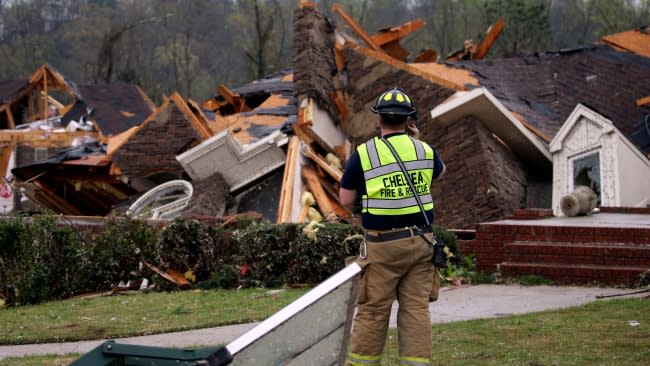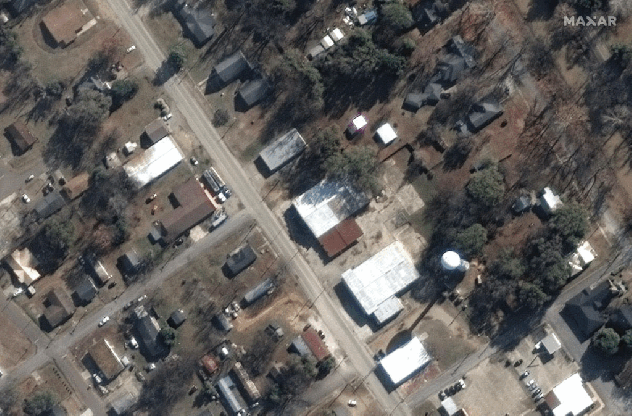Reconstructing the storm: How meteorologists conduct tornado damage surveys
Tornadoes can wreak havoc on communities in minutes, tearing apart some homes and leaving others untouched. These destructive forces of nature can toss vehicles upside down, throw them onto buildings and cause a board of wood to pierce right through the trunk of a massive tree. But not all tornadoes are created equally, and meteorologists survey the damage they leave behind and rate twisters to put their damage into perspective.
The National Weather Service (NWS) conducts storm surveys to provide valuable information about the intensity and the track of the storm to the public. The storm survey reports also help forecasters better understand the weather patterns and improve their forecasting methods.
From the moment the last weather warning expires, the clock starts ticking. A team of meteorologists from the local NWS office is assigned the task of completing a thorough damage survey within 12-48 hours of the twister's touchdown or wind damage.
Before heading to the damage zone, the team packs up a damage survey kit, which includes everything they might need to complete the survey. According to the NWS, these kits typically include a cell phone, a tablet with damage survey software installed, a camera, an atlas and a notebook.
Once at the damage zone, the team collects eyewitness accounts and uses radar data from the time of the event to reconstruct the tornado's life cycle. While the radar data will give them an approximation of when and where the tornado touched down, eyewitness accounts will help the team determine the time and location a twister struck.
Meteorologists document everything from eyewitness reports to photos of the damage. They take note of the types of buildings that were damaged during the storm, which helps them determine a rating.
The first thing to determine is whether wind damage came from a tornado or straight-line winds, which can cause tornadolike damage. The crew finds the answer by looking at the directions in which trees and other debris have fallen or blown away. An aerial survey via helicopter or drone can quickly determine whether a tornado hit or thunderstorm winds resulted in damage. This is an important distinction for meteorologists because historical accounts of tornadoes are kept separate from those of straight-line wind damage.
The NWS categorizes tornadoes by a numerical rating, from zero to five, after assessing the twister's inflicted damage according to the Enhanced Fujita scale.
The original scale is named after Dr. Ted Fujita, who developed the system to help provide a wind estimate for the amount and type of damage that a tornado can produce. In 2007, the Enhanced Fujita scale, EF0 through EF5, was developed by a group of experienced and renowned meteorologists and wind engineers to improve how wind speeds are estimated.
 |
"The EF Scale takes into account more variables and provides a better overall estimate of the wind speed due to the associated storm damage than what the original F-Scale provided," said Guy Pearson, director of weather warning service for AccuWeather Enterprise Solutions. "The EF Scale looks at 28 damage indicators such as trees, building types and structures."
Earlier this year, during a storm survey, Brad Bryant, the meteorologist in charge from the NWS Shreveport, Louisiana, office, told AccuWeather National Reporter Bill Wadell what types of things the team keeps an eye out for when assessing the damage.
"You look at some of the roof structure and how the roof is attached to kind of make some adjustments to what the default rating for a roof ripped off will give you," Bryant said.
In tornado-prone areas, meteorologists have a keen eye for determining the damage category due to their sheer amount of experience. Just by looking at the damaged structures, Bryant can say with confidence what category the damage is consistent with.
"These are well-built structures, and you know, when you start tearing off the roof and taking down parts of [the] walls, you're definitely into the EF2 category, at least," Bryant said.
For the untrained eye, damage consistent with an EF0 tornado can consist of broken tree branches, downed power lines and minor roof damage. An EF0 tornado has wind speeds ranging from 65 to 85 mph.
As the tornado ratings increase, the severity of the damage also increases. An EF1 tornado can still produce all the damage an EF0 tornado can, but instead of broken tree branches, small trees might be uprooted. Other damage can include broken windows, cars blown off roadways, and rolled-over mobile homes. An EF1 tornado has wind speeds ranging from 86 to 100 mph.
An EF2 tornado has wind speeds ranging from 111 to 135 mph, and winds of that force can cause some significant damage. Larger trees will likely be snapped or uprooted, cars will likely be lifted off the ground, and roofs of well-constructed homes could be blown off.
Severe tornado damage occurs with an EF3 tornado, which has wind speeds of 136 to 165 mph. Some walls of well-constructed houses can be torn off. Most trees in the path of the twister will be uprooted or snapped. Heavy cars, as well as structures without a proper foundation, could be lifted and thrown. Since mobile homes don't have any foundation, an EF3 tornado can completely destroy them.
It's important to note that a high-end EF3 twister and all EF4 and EF5 tornadoes can have wind speeds equal to or greater than those found in a Category 5 hurricane, although they are measured differently. This makes tornadoes one of the most violent weather events on the planet.
 |
Before & after satellite photos of Rolling Fork, Mississippi. An EF4 tornado ripped through the town on March 24, 2023. (Satellite image ©2023 Maxar Technologies) |
An EF4 tornado with wind speeds ranging from 166 to 200 mph can cause devastating damage. Most to all walls on a well-built house will likely collapse, and high-rise buildings can sustain significant damage. Buildings constructed of bricks, such as schools, can also collapse.
Lastly, an EF5 tornado, the highest rating a tornado can receive, can create an incredible amount of damage. Wind speeds in an EF5 are in excess of 201 mph. Trees can be debarked with only stubs of large branches remaining. Entire, well-built homes will likely be swept clean off their foundations, and extensive damage to high-rise buildings is possible.
The last EF5 tornado to touch down in the United States was 10 years ago. On May 20, 2013, at least 24 people died after an EF5 tornado wreaked havoc across Moore, Oklahoma. The storm flattened and destroyed more than 300 homes, leaving billions of dollars in damages. The devastating tornado destroyed at least two elementary schools.
 |
A firefighter surveys damage to a house where the family was trapped, but were able to get out after a tornado touches down south of Birmingham, Ala. in the Eagle Point community damaging multiple homes Thursday, March 25, 2021. (AP Photo/Butch Dill) |
Between assessing the construction methods used in damaged buildings and interviewing witnesses, this process can take meteorologists hours to days to weeks to complete depending on the severity of the tornado.
"Not only does it take time for personnel to go out into the field and do the survey, but they do have to get back to the office, analyze all of the data and then publish the preliminary report across multiple dissemination methods," Pearson said.
After completing the survey, the team will issue a Public Information Statement, PNS for short, of the findings. The PNS will state the start and end time of the tornado, the path length and width, what counties it traveled through, how many injuries or fatalities were associated with it and a summary of the storm.
The PNS will be recorded as an official NOAA record in the National Climatic Data Center (NCDC)'s Storm Events Database. However, in rare cases, an NWS office can request the report be modified based on new data.
Verifications, such as post-storm damage surveys, provide valuable information for future forecasts. AccuWeather Senior On-Air Meteorologist Geoff Cornish explained that with tornado warnings, there is a balance between over-warning and under-warning. Too many false alarms can lead to "warning fatigue," making the public less motivated to take shelter. Under-warning is extremely dangerous, too, Cornish explained. This can lead to cases where tornadoes strike without the public having time to react and seek safe shelter.
"Storm surveys and the tornado verification process are so important because it provides a baseline against which meteorologists can grade the warnings," Cornish said. "If an over-warning or under-warning trend is revealed, practices can be adjusted to better keep the public safe."
Want next-level safety, ad-free? Unlock advanced, hyperlocal severe weather alerts when you subscribe to Premium+ on the AccuWeather app.AccuWeather Alerts™ are prompted by our expert meteorologists who monitor and analyze dangerous weather risks 24/7 to keep you and your family safer.





